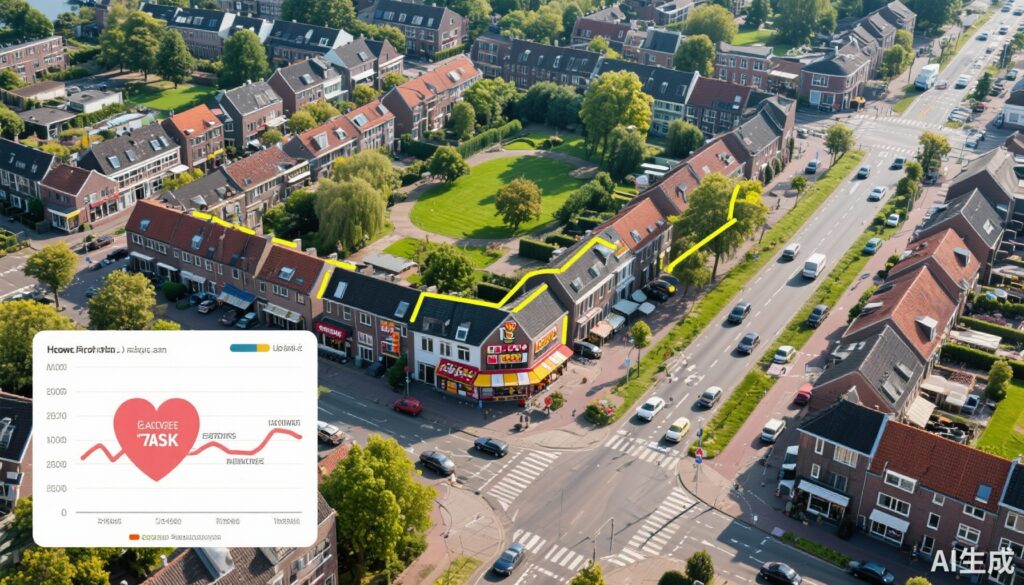Highlight
This large population-based cohort study of 4.4 million Dutch adults demonstrates that living in environments characterized by higher obesogenicity, as measured by the Dutch Obesogenic Built-environmental CharacterisTics (OBCT) index, is associated with an increased risk of cardiovascular disease (CVD) over 14 years. Although individual-level risk increments are modest, the widespread exposure to obesogenic environments translates into a substantial public health burden. The associations are more pronounced among higher-income groups and in areas with elevated air pollution, implicating potential interactions between socioeconomics, environmental factors, and cardiovascular risk.
Background: Burden of Cardiovascular Disease and Environmental Influence
Cardiovascular disease remains a leading cause of morbidity and mortality globally and in the Netherlands. Apart from traditional risk factors such as hypertension, smoking, and hyperlipidemia, obesity is a critical modifiable determinant of cardiovascular risk. Emerging evidence implicates the built environment—comprising physical, social, and economic surroundings—as a key contributor to obesity and related metabolic derangements.
The Dutch Obesogenic Built-environmental CharacterisTics (OBCT) index is a composite measure developed to quantify environmental attributes that predispose individuals to obesity. Previous studies have linked higher OBCT scores with increased body mass index (BMI), waist circumference, and prevalence of obesity. However, the relationship between obesogenic environments and hard cardiovascular outcomes has not been fully elucidated at the population level.
Study Design and Methods
This longitudinal, population-based cohort study included 4.4 million adults aged 40 years and older residing in the Netherlands as of January 1, 2006, without a prior history of cardiovascular disease. Inclusion required stable residence at the same address from 2004 through the study endpoint (December 31, 2019) or death. The primary exposure was the OBCT index, a composite, scaled 0–100 measure of obesogenicity assigned at baseline based on participants’ residential environment.
The main outcomes were incident cardiovascular disease events over 14 years, categorized as overall CVD incidence, coronary heart disease (CHD), stroke, and heart failure (HF). CVD mortality was also analyzed. Cox proportional hazards models estimated hazard ratios (HRs) and 95% confidence intervals (CIs), adjusting for relevant covariates. Stratified analyses considered income groups and air pollution exposure to evaluate effect modification.
Key Findings
The study found that each 10-point increase in the OBCT index was associated with a 1.1% higher risk of any CVD event (HR: 1.011; 95% CI: 1.009–1.013). Critically, individuals in the highest quintile of OBCT scores had a 4.9% increased risk of CVD compared to those in the lowest quintile (HR: 1.049; 95% CI: 1.038–1.060). This corresponded to an additional 37 cardiovascular events per 10,000 persons over 10 years, quantifying the public health impact of obesogenic environments.
Regarding subtypes of CVD, a 10-point higher OBCT score conferred a 1.1% increased risk for coronary heart disease, 0.9% for stroke, and 1.2% for heart failure. Cardiovascular mortality also rose by approximately 1.0% per 10-point increment in OBCT score.
Subgroup analyses revealed stronger associations among individuals in the highest income groups, suggesting differential vulnerability or interaction with lifestyle factors. Similarly, participants exposed to higher levels of air pollution exhibited amplified risks, highlighting potential synergistic environmental hazards contributing to cardiovascular pathology.
Expert Commentary and Interpretation
This extensive Dutch cohort study robustly establishes a link between environmental obesogenic characteristics and cardiovascular disease risk, reinforcing the paradigm that the built environment shapes cardiometabolic health beyond individual behaviors alone.
Though the relative risk increases are modest at the individual level, they are epidemiologically significant due to the ubiquitous nature of environmental exposures. The findings support the biological plausibility whereby obesogenic environments promote adiposity, metabolic dysfunction, inflammation, and ultimately atherosclerotic disease. Interaction with air pollution underscores the complexity of urban health determinants, warranting multifactorial preventive strategies.
Limitations include potential residual confounding by lifestyle or genetic factors not captured in environmental metrics. Stability of residence minimizes exposure misclassification but may introduce selection bias. Generalizability is strongest for similar high-income, urbanized populations, and application to rural or diverse societies may require validation.
Conclusion and Clinical Implications
The Dutch OBCT index is a valuable tool linking obesogenic environmental factors with long-term cardiovascular outcomes. These results emphasize the importance of urban planning and public health policies that reduce obesogenic exposures, improve walkability, increase access to healthy food, and mitigate air pollution to lower cardiovascular disease burden.
Clinicians should recognize environmental determinants as contributors to patients’ cardiovascular risk profiles, particularly in urban settings. Incorporating environmental assessments could aid risk stratification and personalized prevention.
Future research should explore interventions at the community level to modify these environmental risks and assess their impact on obesity and cardiovascular events. Multidisciplinary collaboration between cardiology, public health, environmental science, and urban planning is essential for effective risk reduction.
Funding
This study was supported by the EXPOSOME-NL consortium, funded by the Gravitation programme of the Dutch Ministry of Education, Culture, and Science and the Netherlands Organization for Scientific Research (NWO grant number 024.004.017).
References
Meijer P, Lam TM, Beulens JW, Grobbee DE, Lakerveld J, Vaartjes I. Association between the Dutch Obesogenic Built-environmental CharacterisTics (OBCT) index and 14-year cardiovascular disease incidence: a population-based cohort study of 4.4 million adults. Lancet Reg Health Eur. 2025 Oct 15;59:101494. doi: 10.1016/j.lanepe.2025.101494. PMID: 41142660; PMCID: PMC12550154.



